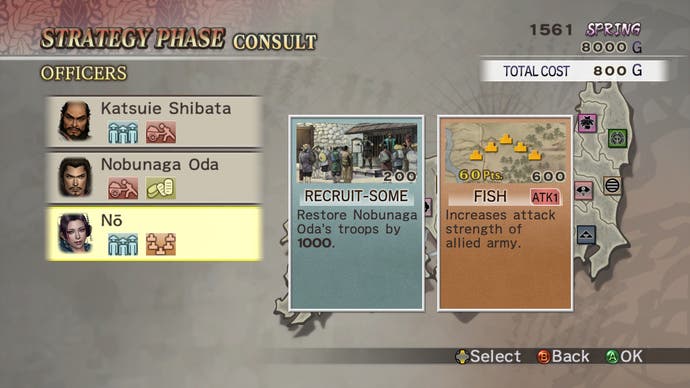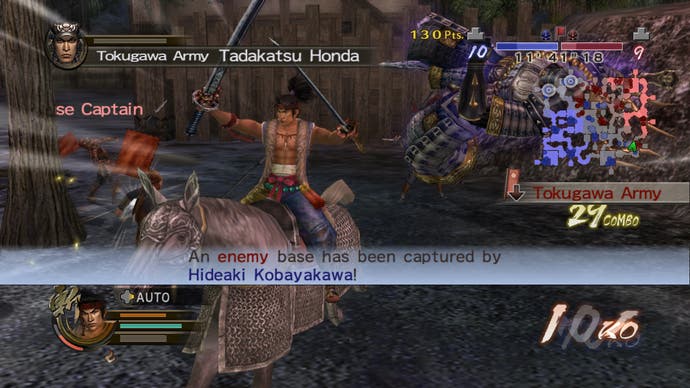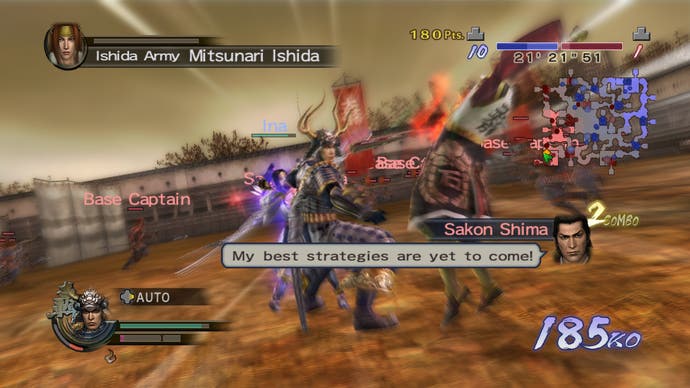Samurai Warriors 2 Empires
Samurai-ke, some you don't. We like.
So get this. Samurai Warriors 2 Empires is actually the third game in the Warriors Empires series, but it's the fifth game in the Samurai Warriors series, and about the 19th game in the overall Warriors series, depending on how many spin-offs you include when you're counting. But despite that 2 in the title, it's actually the first Samurai Warriors Empires title, which means it's the first time that Koei have applied the strategic dimension introduced in Dynasty Warriors 4: Empires and refined in Dynasty Warriors 5 to the Japanese setting of the Samurai Warriors series. Got that?
It's the sort of sequelitis that leaves most reviewers staring glassy-eyed before they've even started playing the game, their enthusiasm sapped by the prospect of yet another battlefield strategy action epic. It shouldn't. Although they certainly do contain their fair share of overpopulated battlefields to hack and slash your way through, the games in the Empires series are quite different from the regular Warriors titles. For starters, the dynamic battlefield strategy of the regular games is wrapped up in a more sedate and cerebrally challenging, Risk-like turn-based strategy game.
The object of the game is to challenge rival clans for control over Japan's 25 warring territories, with various scenarios providing different starting conditions. Each turn sees you execute a number of orders. Domestic policies keep the populace happy and pacified, or raise income. You can then use that income to hire or train more troops or officers, or to improve your army's weaponry. Or you can engage in diplomatic measures signing treaties and forming alliances, or conducting trade with distant territories. It's all very intuitive stuff, made more so by your leading generals, who provide plenty of helpful advice. You are, of course, free to ignore them though. Instead you can just choose from one of 90 policy cards that are gradually unlocked over the course of the game, with each card representing a different order (and 50 cards inspired by the game's Japanese setting and distinct from previous Empires games, apparently).

At the end of each turn you're free to engage in combat: to defend your territories, to acquire new territories, or to support your allies in battle. Once on the battlefield, the action is similar to regular Warriors games. Which is to say (if you still haven't gotten round to playing one of the 18-odd titles in the series so far), that it's your job to bash about a million enemy foot soldiers about. It's also your job to deal with any roving officers while filtering out the battlefield noise of officers offering encouragement or information, or just plain jabbering, in order to suss out the most effective route to victory. Normally this will involve a judicious use of your combat rolls, musou attacks, special moves and charge attacks, while using the d-pad to issue orders to your colleagues and underlings.
In a neat twist ushered in with Empires, though, it will also involve capturing enemy bases. Unlike the regular Warriors games, which feature various types of pre-configured scenarios, the battles in Samurai Warriors 2 Empires all require you to make your way across the battlefield to the enemy's base camp. Each battlefield is dotted with bases connected to each other by criss-cross lines, and your job is to capture the enemy base camp by taking enemy bases along the way, in order to establish an uninterrupted supply chain. It's an interesting twist on the Samurai Warriors formula, and it gives battles a greater sense of strategic depth, as you attempt to balance the need to push forward with the need to defend and maintain an unbroken supply line.

This game's tactical depth is further enhanced by the addition of new formation cards. Apparently these reflect actual formations that Samurai used to use or something. Whatever. What's important is that they can be acquired over the course of the turn-based game and they can be used during battles to gain the upper hand over your opponent: attacking formations are superior to mobile configurations, which are superior to defensive measures, which are superior to (you guessed it) attacking formations.
Even with this invigorated sense of strategic choice, though, it could be argued that the fairly rigid battle structure can get a little bit repetitive. In spite of the varied battlefield maps and starting dispositions (and weather - there are some fairly pretty snow scenes, for example), these combat missions lack the variety of scenarios on offer in the pure-bred battlefield action in the regular Warriors games. Nevertheless, the constraints and demands of the over-arching turn-based strategy game give each battle a context that manages to maintain your interest throughout the course of the game.

Samurai Warriors 2 Empires also offers a number of minor improvements over its predecessors. If the 400 playable officers aren't enough for you it's possible to create your own. If you're not in the mood for turn-based strategy it's possible to fire up a game in Free Mode to just dip into the battlefield action. If you're in the mood for a bit of multiplayer action there's a two-player co-operative mode. And if you're into archives, there's an extensive section containing all sorts of artwork and other media.
So while people often complain about successive iterations of the Warriors games as if you're only allowed to make sequels to sports games, Samurai Warriors 2 Empires really does offer something substantially different to previous titles in the series. As the first application of the Empires formula to the arguably more appealing Japanese setting of the Samurai Warriors games, it's distinct from both the purely battlefield action of the Samurai Warriors titles, and the solely Chinese setting of the previous Empires games. So the only niggle is not that this doesn't sufficiently differentiate itself from previous games in the series. No, the only niggle is that the combat camera angle is too low. And that's not really much of a niggle. So sure, it may not everybody's cup of Japanese green tea. But it's another decent title in a decent series of games.
